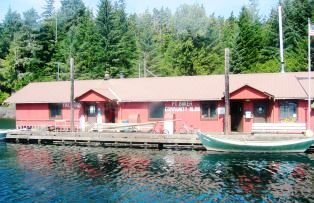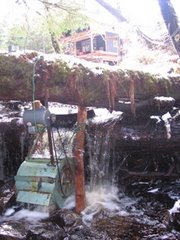The post I did on my shrimping trip didn't have any photos. It was sooooo busy the first few days that I couldn't even step away to take some shots but I did get a few.

This one shows the unique design(for AK shrimp boats) of lining up the string of pots on a rail. This saves having to haul them up and over the freeboard and each string of five pots can be kept together until their final resting spot in the water is found. I feel like the lobster boats back home did this rail set up too. Each of the five pots is connected to a longline, which is set to be however deep, maybe 50 to 75 fathoms. The long line has a buoy on the other end so that they can find it again. Above, Dean and Chris are bringing up the last pot in the string. The pots are lined up so that when Dean, the captain, steams over to the right spot he tells Chris over the loud speaker. Chris tells him the number on the buoy so Dean can mark it on his chart to keep track of where all his pot strings are, and also keep track of how well he is doing in each area.

When Dean steams back to the buoys that are in the water, Chris snaggs the buoy out of the water with a gaff, gets it loaded on the block (the metal wheel thing behind Dean's head) and Dean runs down to the deck from the wheelhouse and they pull each one over the side onto the rail. There are some bungees that open up and the shrimp fall into a tote below the rail. Even though the pots are big(75-125 lbs each), one will average about 10 pounds of shrimp per good set because shrimp are creatures of space. They don't like to be close to each other, and if they are they have long spears on top of their heads that they can stab each other with, but mostly they just stab us while we sort them.

This is the sorter that I mostly worked on. I would grab the shrimp out of the tote on the deck and put them into baskets that held about fifty pounds each. The first few days we were doing so well that each set would get a full basket and maybe half of another basket. Then I would take them into the sorting room(just a tarp that divides the deck into two spaces) and run them through the sorter you can see in the above photo. The shrimp are dumped into the tray and I push them one by one onto the rollersthat gradually get wider. This way they are sorted into smalls, mediums, large, extra large, jumbo, and super jumbo.
The boat I was working on sold their shrimp to a cannery that sells them on the Japanese sushi market. We were provided with very, very specific directions for handling the shrimp because our boat was considered a catcher/processor. The goal was to get the shrimp from the water, through the processing and into the freezer as fast as possible so that they are frozen alive. Misty and I were the processors. From the sorter, they were dipped into something that makes them poop so they don't have that unattractive bleck vein in them. I got to make that dip solution every 200 lbs. mmmmmmmm. I called the dip bucket the cess pool.

From there they were given to Misty who is the master finger packer. She worked on an other boat that marketed their own shrimp. She was trained by a Canadian lady who works with the Japanese buyers and knows how they like their shrimp to be presented. Misty has done this for a few years so she is very good at it. For every one case that I could finger pack to the specifications she could do four or five cases. The shrimp aesthetic goes something like this: shrimp are lined up in two layers with all legs and antennae tucked under and eyeballs lined up in a perfect line, their butts are tucked under and their swords have to alternate facing left and right, and each box has to be with in grams of the size specification that they have been sorted by. Then they have to go into the freezer. However the freezer can't be opened that often or else it doesn't stay a the required -30 degrees F. We finally got a system down and we think that the shrimp were out of the water and into the freezer somewhere between 45 minutes and and hour. We hustled. We worked hard and lifted crazy heavy stuff. My face was still healing and my hands were raw and punctured. But this fishery only goes from 8 am to 4 pm. So at night we holed up in a protected cove and ate really well, watched movies, and did anything else you can imagine that goes on on fishing boats like:

Haircuts
I was only on the boat for the early part of the season, Chris left a little bit after me. For the last month or so of the season, it was just Misty and Dean working the pots. She did all the pots on the rail, got the lines ready, and all the processing herself. A lot of hard work, I admire Misty and Dean a whole bunch for the insane work that they do and am glad that I had a chance to work with them. Thanks guys.
 Shortly after I got back from shrimping, the teacher in our school quit. He and his wife were from Florida and wanted to give Alaska a try. So they tried for two months and it just wasn't what they were looking for. So the I was asked to be a substitute teacher until they can find another teacher to move up here half way through the school year. They haven't found anyone yet. If you're interested please see http://www.sisd.org/ .
Shortly after I got back from shrimping, the teacher in our school quit. He and his wife were from Florida and wanted to give Alaska a try. So they tried for two months and it just wasn't what they were looking for. So the I was asked to be a substitute teacher until they can find another teacher to move up here half way through the school year. They haven't found anyone yet. If you're interested please see http://www.sisd.org/ . last week. They are enrolled in another school on the island. We took them snowshoeing on a nearby logging road and had lunch in an old rock pit. There are six girls (ages 12-17) and one boy in my class. Having some fresh blood in town caused the hormones to rage. The girls who didn't want to go in the first place were now fighting over leaving. At lunch I overheard the boy say to the exchange students "Remember in America, it is always the man's fault".
last week. They are enrolled in another school on the island. We took them snowshoeing on a nearby logging road and had lunch in an old rock pit. There are six girls (ages 12-17) and one boy in my class. Having some fresh blood in town caused the hormones to rage. The girls who didn't want to go in the first place were now fighting over leaving. At lunch I overheard the boy say to the exchange students "Remember in America, it is always the man's fault".
 last week. They are enrolled in another school on the island. We took them snowshoeing on a nearby logging road and had lunch in an old rock pit. There are six girls (ages 12-17) and one boy in my class. Having some fresh blood in town caused the hormones to rage. The girls who didn't want to go in the first place were now fighting over leaving. At lunch I overheard the boy say to the exchange students "Remember in America, it is always the man's fault".
last week. They are enrolled in another school on the island. We took them snowshoeing on a nearby logging road and had lunch in an old rock pit. There are six girls (ages 12-17) and one boy in my class. Having some fresh blood in town caused the hormones to rage. The girls who didn't want to go in the first place were now fighting over leaving. At lunch I overheard the boy say to the exchange students "Remember in America, it is always the man's fault".









































 This is our no frills gas price... Yup that's $3.70/gallon. We have our own key to the pump so it's 24/7 service and they just send us the bill every month. Whoopeee.
This is our no frills gas price... Yup that's $3.70/gallon. We have our own key to the pump so it's 24/7 service and they just send us the bill every month. Whoopeee.





